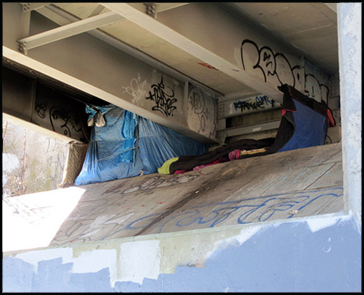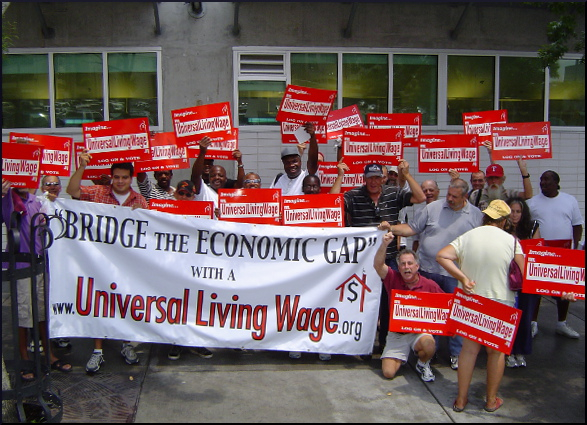
In many ways and places, our veterans are being abused, while the public is bamboozled by the old magician’s trick of misdirection. When a major event is scheduled, an entire municipality might play “hide the homeless.” On an individual level, the media get all in a tizzy over whether one homeless New Yorker had boots or didn’t have boots before a police officer gave him some.
The latest cultural hiccup is a video made just in time for Veterans Day, in which homeless Army vet Jim Wolf gets a shave and a haircut. And a dye job. Also, he wears a suit. “Now he looks like someone on the cover of GQ,” filmmaker Rob Bliss told ABC News, and went on to say:
It’s more than just a haircut and clothing. To see yourself look like that is to see that potential. There are things inside implied by the way you look outside — stability and peace of mind.
Really? Males on active duty in the U.S. military are closely trimmed and clean-shaven. Do they all possess stability and peace of mind? If so, why do we hear so much about Post Traumatic Stress Disorder? The video is based on the assumption that barbering is a panacea. If this were so, all of the thousands of homeless men who have been given complimentary shaves and haircuts by volunteers would be prosperous citizens by now.
The makeover video racked up 15 million YouTube views and inspired dozens of blog posts full of oohs and aahs. At the end of the slickly produced vignette, two screens of text explain that Wolf has taken control of his life and “is now scheduled to have his own housing and is attending Alcoholics Anonymous meetings for the first time ever.”
Smoke and Mirrors
As it turns out, “scheduled to have his own housing” was word waffling. When the video was made, Wolf had applied for veteran housing. How long that takes, and what a person does during the wait, is anybody’s guess. Meanwhile, the video raised $30,000 for Degage Ministries. And then a bad thing happened. BarstoolSports.com has its finger on the pulse of America, so let their headline tell the story and their writer Jmac sum it up:
“Dude From That Super Viral Homeless Makeover Video Got Arrested For Causing A Disturbance At Burger King”
Neat idea for sure, but this is the real world, folks. A new suit and haircut doesn’t guarantee that a dude is all of a sudden gonna turn his life around. This seems to happen a lot with stories like this. People only wanna discuss the happy theatrics of the whole thing, but they tend to ignore the facts.
For CNN News, Dorrine Mendoza interviewed Jim Wolf’s sister. Robin Thomas has hoped for many years that her brother would eventually exit the cycle of “depression, alcoholism, unresolved grief and chronic homelessness” in which he has been caught. Mendoza writes:
No one disputes Wolf has been arrested dozens and dozens of times, mostly for misdemeanors such as public intoxication. Thomas says her brother “lives in survival mode”…. She also admits that perhaps the video did not give Wolf the “glimpse into the future” that others had hoped. He did not view it as a life-changing event, Thomas says.
Though Degage Ministries put Jim Wolf and Rob Bliss in touch with each other, it’s not clear whether the film was originally conceptualized by the organization or the filmmaker. Someone made a bad decision when picking the person to be “made over.” Everybody is different, but whatever this particular fellow needs, it isn’t a shower of publicity. Jim Wolf might be a great candidate for a Housing First program — with zero fanfare — but he definitely was not ready for this failed experiment in superficial making-over.
Into the Wayback Machine
Another premise on which this project rests is a throwback to the 1960s, when acrimonious hair-length discussions between fathers and sons obscured the serious issues that activists sought to expose and repair. Is that what is happening here? Before Jim Wolf was arrested, Philip J. Reed — contravening popular opinion — wrote a piece titled, “Why I Hate This ‘Homeless Veteran Makeover’ Video, and Why You Should Too.” He calls it absurd, manipulative, offensive, exploitative, embarrassing and demeaning. Reed says:
What, exactly, is meant to be inspiring about this again? It’s the hollowest possible kind of “inspiration,” and it’s one that only works because it withholds the humanity…. But you shouldn’t feel inspired by anything that takes a serious, profound problem with the very core of the society in which you live, and presents it as trivial and easily overcome.
Wolf has a problem. That problem is the country he lives in. That problem is that country’s approach to dealing with the sick and the poor and the unemployed and the homeless. That problem is emphatically not going to be solved by a haircut, a shave, and a necktie. And yet this makeover video wants you to come away feeling that it is solved that way. Because that’s easy. That’s visual. And, what’s more, it’s easy on the eye.
This constant whitewashing of our problems is the problem.
Source: “Homeless Vet’s Makeover Turns His Life Around,” ABCNews.go.com, 11/08/13
Source: “Dude From That Super Viral Homeless Makeover Video Got Arrested For Causing A Disturbance At Burger King,” BarstoolSports.com, 11/21/13
Source: “Homeless vet in makeover video has long road ahead,” CNN.com, 11/19/13
Source: “Why I Hate This “Homeless Veteran Makeover” Video, and Why You Should Too,” NoiselessChatter.com, 11/09/13
Image by Rob Bliss













